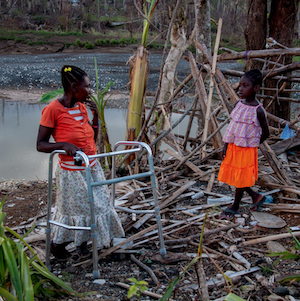 A Houston-area man is rescued by helicopter after Hurricane Harvey. ©Daniel Farrell, U.S. Air National Guard, 2017.
A Houston-area man is rescued by helicopter after Hurricane Harvey. ©Daniel Farrell, U.S. Air National Guard, 2017.
By Laura Stough
As Houston and the 58 disaster-declared counties that surround it begin the long process of post-Harvey recovery, important pre-existing inequities will be revealed. The widespread flooding produced by Hurricane Harvey affected approximately 6 million people, including people living with mobility, sensory, cognitive, and mental health disabilities. Given the disability rate in Texas of 18.7 percent, approximately a million people with disabilities have been directly affected by this disaster.
People with disabilities are more likely to lose their homes, to have property damage, and to die in disasters. They are more likely to be separated from their family members, overlooked by relief volunteers in shelters, and to suffer injuries or health-related complications. Compounding these difficulties, people with disabilities already were more likely to live in poverty, be unemployed, and have limited access to health care before the storm. These factors suggest disaster recovery for these families will take longer and be more complicated on many fronts.

A Haitian woman with mobility issues navigates debris after Hurricane Matthew. ©Christian Blind Mission UK, 2016.
Restoring Disability-Related Resources and Services
Since Harvey made landfall, the Center on Disability and Development at Texas A&M University has tracked numerous reports about the critical resources needed by people with disabilities. While most people experiencing disaster have the same immediate necessities—food, shelter, and medical attention—those with disabilities can have additional requirements, such ramps in shelters, special formulas for babies, food for assistance dogs, and access to sign language interpreters. Perhaps most commonly needed post-disaster is durable medical equipment such as wheelchairs, walkers, oxygen equipment, and hearing aids.
Conditions in shelters can be particularly challenging for individuals who need accessible toilets and showers or electricity for motorized wheelchairs, ventilators, and cardiac devices. More than 20 percent of individuals with a disability require assistance with self-care or independent living activities such as bathing, dressing, or preparing meals. The widespread impact of Hurricane Harvey means that the home health care aides and family members who normally provide this support may also have been affected, disrupting continuity of care. In addition, services such as physical therapy, speech therapy, dialysis, or medical support all have the opportunity to be interrupted in the post-Harvey environment.
Recovering Through Access to Disaster-Related Resources
More than 93 percent of individuals with disabilities in Texas live in the community rather than in institutional, nursing home, or residential care. Equal access to disaster-related information enables people with disabilities who live independently to participate in their own recovery. However, populations with hearing disabilities will need information in print or sign language, while people with reading or cognitive disabilities will need materials easy to read. People with disabilities already encounter barriers in housing, transportation, and employment. Case managers with disability-related expertise can navigate the complex recovery process and connect them to disaster-related resources. Such resources are essential to ensuring a complete and equitable recovery process.
Rebuilding for Accessibility and Inclusion
Many of the homes lost during Hurricane Harvey by people with disabilities would have had modifications such as ramps, alerting systems, and adapted bathrooms. Similarly, cities and towns lost crosswalks with alert features, buses with wheelchair lifts, dialysis centers, and home health services that enabled people to live in their communities. An estimated 300 schools, most which provided special education services, have sustained damage. To serve these students, special instructional materials and communication devices will need to be replaced and access to special educational records restored.
Unfortunately, past disasters show that people with disabilities will continue to face barriers unless public infrastructure is built back in a way that supports accessibility. Accessibility applies not only to buildings, but also to transportation, communication, education, and healthcare systems. Universal building design principles should be used to build back better so that people with diverse physical, sensory, and cognitive abilities are not differentially threatened by future disasters. Such design often serves other populations, too—for instance, ramped entryways facilitate quicker evacuations than stairs.
Although people with disabilities will face different difficulties during Hurricane Harvey recovery, they will share the same goals as other survivors—most want to return to their homes, neighborhoods, and towns. However, we need to consider how to redesign and reconstruct those homes, neighborhoods, and towns during the rebuilding process so that new infrastructure is accessible and inclusive for all of the survivors of Hurricane Harvey, as well as resilient to disasters yet to come.
Laura Stough is a professor of educational psychology at Texas A&M University and leads Project REDD: Research and Education on Disability and Disaster at the Center for Disability and Development. She has produced more than 50 academic publications on the social, educational, and psychological experiences of individuals with disabilities, including the book Disaster and Disability: Explorations and Exchanges, co-edited with Ilan Kelman.